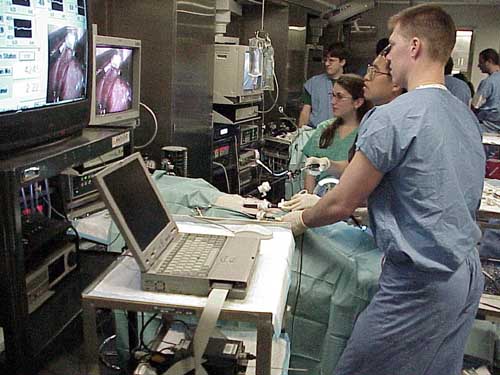Markov Models of MIS based on Force/Torque Signatures and Tool/Tissue Interactions
Background
The best method of training for laparoscopic surgical skills is controversial. Some advocate observation in the operating room, while others promote animal and simulated models or a combination of surgery-related tasks. A crucial process in surgical education is to evaluate the level of surgical skills. For laparoscopic surgery, skill evaluation is traditionally performed subjectively by experts grading a video of a procedure performed by a student. By its nature, this process uses fuzzy criteria. The objective of the current study was to develop and assess a skill scale using Markov Models (MM).

Methods
Ten surgeons (5 Novice Surgeons - NS; 5 Expert Surgeons - ES) performed a cholecystectomy and Nissen fundoplication in a porcine model. An instrumented laparoscopic grasper equipped with a three-axis force/torque sensor was used to measure the forces/torques (F/T) at the hand/tool interface synchronized with a video of the tool operative maneuvers. A synthesis of frame-by-frame video analysis and a vector quantization algorithm, allowed to define force/torque signatures associated with 14 different types of tool/tissue interactions.
Results
The magnitude of F/T applied by NS and ES were significantly different (p<0.05) and varied based on the task being preformed. High F/T magnitudes were applied by NS compared to ES while performing tissue manipulation and vise versa in tasks involved tissue dissection. From each step of the surgical procedures, two MM were developed representing the performance of 3 surgeons out of the 5 in the ES and NS groups. The data obtained by the remaining 2 surgeons in each group were used for evaluating the performance scale. The final result was a surgical performance index which represented a ratio of statistical similarity between the examined surgeon's MM and the MM of NS and ES. The difference between the performance index value, for a surgeon under study, and the NS/ES boundary, indicated the level of expertise in the surgeon's own group. Using this index, 87.5% of the surgical procedures were correctly classified into the NS and ES groups. The 12.5% of the procedures that were misclassified were preformed by the ES and classified as NS. However in these cases the performance index values were very close to the NS/ES boundary.
Conclusions
The data suggest that a performance index based on MM and force/torque signatures provides an objective means of distinguishing NS from ES. In addition this methodology can be further applied to evaluate haptic virtual reality surgical simulators for improving realism in surgical education.
Device
Instrumented laparoscopic Tool
| Status: Completed |
PUblications
(*) Note: Most of the Bionics Lab publications are available on-line in a PDF format. You may used the publication's reference number as a link to the individual manuscript.
[![]() JP4] Richards Christina, Jacob Rosen, Blake Hannaford, Mark MacFarlane, Carlos Pellegrini, Mika N. Sinanan, Skills Evaluation in Minimally Invasive Surgery Using Force/Torque Signatures, Surgical Endoscopy, Vol 14, No. 9, pp. 791-798.
JP4] Richards Christina, Jacob Rosen, Blake Hannaford, Mark MacFarlane, Carlos Pellegrini, Mika N. Sinanan, Skills Evaluation in Minimally Invasive Surgery Using Force/Torque Signatures, Surgical Endoscopy, Vol 14, No. 9, pp. 791-798.
[![]() JP5] Rosen Jacob, Blake Hannaford, Richards Christina, Mika N. Sinanan, Markov Modeling of Minimally Invasive Surgery Based on Tool/Tissue interaction and Force/Torque Signatures for Evaluating Surgical Skills, IEEE Transactions on Biomedical Engineering Vol. 48. No. 5, pp. 579-591 May 2001.
JP5] Rosen Jacob, Blake Hannaford, Richards Christina, Mika N. Sinanan, Markov Modeling of Minimally Invasive Surgery Based on Tool/Tissue interaction and Force/Torque Signatures for Evaluating Surgical Skills, IEEE Transactions on Biomedical Engineering Vol. 48. No. 5, pp. 579-591 May 2001.
[![]() JP7] Rosen Jacob, Massimiliano Solazzo, Blake Hannaford, Mika N. Sinanan, Objective Evaluation of Laparoscopic Skills Based on Haptic Information and Tool/Tissue Interactions, Computer Aided Surgery, Volume 7, Issue 1, pp. 49-61 July 2002.
JP7] Rosen Jacob, Massimiliano Solazzo, Blake Hannaford, Mika N. Sinanan, Objective Evaluation of Laparoscopic Skills Based on Haptic Information and Tool/Tissue Interactions, Computer Aided Surgery, Volume 7, Issue 1, pp. 49-61 July 2002.
[![]() CP3] Rosen Jacob, Mark MacFarlane, C. Richards, Blake Hannaford, Carlos Pellegrini, Mika N. Sinanan, Surgeon/Endoscopic Tool Force-Torque Signatures In The Evaluation of Surgical Skills During Minimally Invasive Surgery, Studies in Health Technology and Informatics - Medicine Meets Virtual Reality, Vol. 62, pp. 290-296, IOS Press, January 1999.
CP3] Rosen Jacob, Mark MacFarlane, C. Richards, Blake Hannaford, Carlos Pellegrini, Mika N. Sinanan, Surgeon/Endoscopic Tool Force-Torque Signatures In The Evaluation of Surgical Skills During Minimally Invasive Surgery, Studies in Health Technology and Informatics - Medicine Meets Virtual Reality, Vol. 62, pp. 290-296, IOS Press, January 1999.
[![]() CP4] Rosen Jacob, C. Richards, Blake Hannaford, Mika N. Sinanan, Hidden Markov Models of Minimally Invasive Surgery, Studies in Health Technology and Informatics - Medicine Meets Virtual Reality, Vol. 70 pp. 279-285, IOS Press, January 2000.
CP4] Rosen Jacob, C. Richards, Blake Hannaford, Mika N. Sinanan, Hidden Markov Models of Minimally Invasive Surgery, Studies in Health Technology and Informatics - Medicine Meets Virtual Reality, Vol. 70 pp. 279-285, IOS Press, January 2000.
[![]() CP5] Rosen Jacob, Massimiliano Solazzo, Blake Hannaford, Mika N. Sinanan , Objective Evaluation of Laparoscopic Surgical Skills Using Hidden Markov Models Based on Haptic Information and Tool/Tissue Interactions, American College of Surgeons Annual Meeting - Washington State Chapter, Lake Chelan, June 2000.
CP5] Rosen Jacob, Massimiliano Solazzo, Blake Hannaford, Mika N. Sinanan , Objective Evaluation of Laparoscopic Surgical Skills Using Hidden Markov Models Based on Haptic Information and Tool/Tissue Interactions, American College of Surgeons Annual Meeting - Washington State Chapter, Lake Chelan, June 2000.